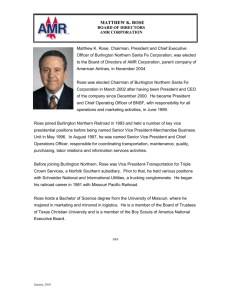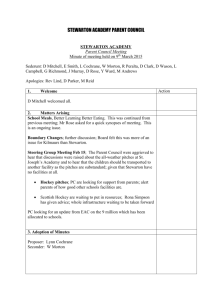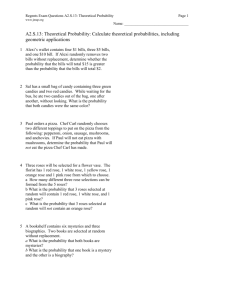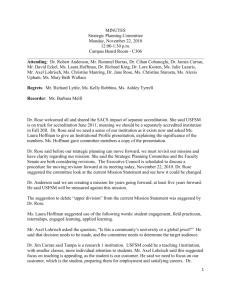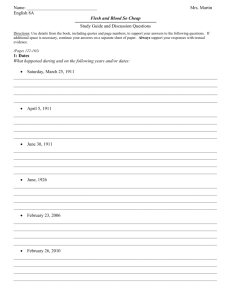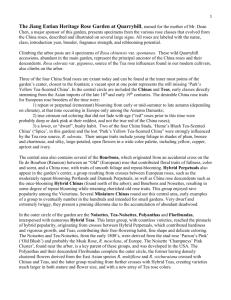ROSE-FOR-THE-LANDLORD
advertisement
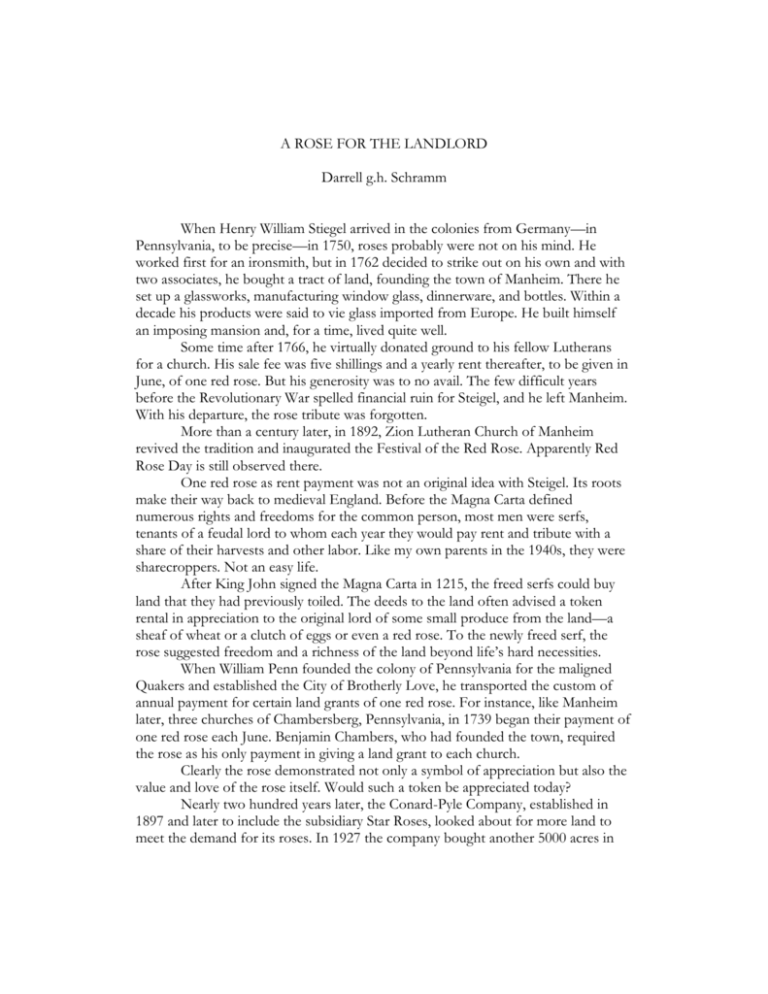
A ROSE FOR THE LANDLORD Darrell g.h. Schramm When Henry William Stiegel arrived in the colonies from Germany—in Pennsylvania, to be precise—in 1750, roses probably were not on his mind. He worked first for an ironsmith, but in 1762 decided to strike out on his own and with two associates, he bought a tract of land, founding the town of Manheim. There he set up a glassworks, manufacturing window glass, dinnerware, and bottles. Within a decade his products were said to vie glass imported from Europe. He built himself an imposing mansion and, for a time, lived quite well. Some time after 1766, he virtually donated ground to his fellow Lutherans for a church. His sale fee was five shillings and a yearly rent thereafter, to be given in June, of one red rose. But his generosity was to no avail. The few difficult years before the Revolutionary War spelled financial ruin for Steigel, and he left Manheim. With his departure, the rose tribute was forgotten. More than a century later, in 1892, Zion Lutheran Church of Manheim revived the tradition and inaugurated the Festival of the Red Rose. Apparently Red Rose Day is still observed there. One red rose as rent payment was not an original idea with Steigel. Its roots make their way back to medieval England. Before the Magna Carta defined numerous rights and freedoms for the common person, most men were serfs, tenants of a feudal lord to whom each year they would pay rent and tribute with a share of their harvests and other labor. Like my own parents in the 1940s, they were sharecroppers. Not an easy life. After King John signed the Magna Carta in 1215, the freed serfs could buy land that they had previously toiled. The deeds to the land often advised a token rental in appreciation to the original lord of some small produce from the land—a sheaf of wheat or a clutch of eggs or even a red rose. To the newly freed serf, the rose suggested freedom and a richness of the land beyond life’s hard necessities. When William Penn founded the colony of Pennsylvania for the maligned Quakers and established the City of Brotherly Love, he transported the custom of annual payment for certain land grants of one red rose. For instance, like Manheim later, three churches of Chambersberg, Pennsylvania, in 1739 began their payment of one red rose each June. Benjamin Chambers, who had founded the town, required the rose as his only payment in giving a land grant to each church. Clearly the rose demonstrated not only a symbol of appreciation but also the value and love of the rose itself. Would such a token be appreciated today? Nearly two hundred years later, the Conard-Pyle Company, established in 1897 and later to include the subsidiary Star Roses, looked about for more land to meet the demand for its roses. In 1927 the company bought another 5000 acres in Pennsylvania. Robert Pyle, the head of the firm at that time, discovered that the original land had been granted in 1731 to William Penn, grandson of the founder of the state. The rental terms written into the deed included “one Red Rose . . . yearly, if the same be demanded.” Pyle wished to revive the custom. (It was Pyle, by the way, who gave the American name to the famous Meilland rose of WWII we know as ‘Peace’.) In 1937 he initiated a ceremony, bequeathing a red rose to the president of the local rose society. That occasion seemed too bland. By the next year he had located a ninth generation descendant of William Penn living not far from the rose fields and invited him to Rose Rent Day. At the 1938 ceremony he presented the descendant, Philip Penn-Gaskell Hall, with 205 roses as back rent from 1731. The following year, Conard-Pyle continued the custom but also used Red Rose Day to introduce new roses. One of the roses introduced that day was the miniature ‘Baby Gold Star’, which is still somewhat available. In 1940, it paid the rent with the famous ‘Crimson Glory’. A rose introduced that year, and still on the market, was ‘Blanche Mallerin’. And so the tradition continued. Nearly each year from 1964 to 1978 ‘Mister Lincoln’ was the rose presented as token. In 1978 Alain Meilland of France—who in January 2012 was honored at The Huntington as a Great Rosarian of the World—he and his daughter presented the rose as rent. At that ceremony, Robert Linquist introduced his deep pink hybrid tea ‘Friendship’ and Griffith Buck his ‘Carefree Beauty’, a rose that has achieved an Earth Kind designation today. Over the years to this event, at one time or another, have come most of the American Rose Society presidents as well as many a famous rose breeder, such as Reimer Kordes of Germany, Sam McGredy of Ireland and later New Zealand, Walter Lammerts, Herb Swim, Bill Warriner, O.L. Weeks, all of the United States, and Harry Wheatcroft of England. For at least 47 years Rose Rent Day has held its annual ceremony. The celebration seems to have died in 1984. While I did learn from the Conard-Pyle Co. that the occasion is no longer celebrated, Chester County, home of extensive fields growing Star Roses, has been urging that the tradition be renewed. In the meantime, I can’t help but think, what would it mean today if all of us annually presented the owner or former owner of our property with the goodwill of one red rose? Not to be used or reprinted without permission of the author.



